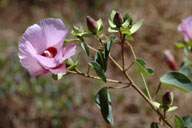In Flower This Week
A news sheet prepared by a Gardens' volunteer.
Numbers before each plant refer to temporary IFTW labels in the gardens.
Numbers in square brackets [ ] refer to garden bed Sections. Plants in flower are in bold type.
View past issues of 'In Flower This Week'.
29 April 2015
Gossypium sturtianum
click for larger image |
Today we will visit the Red Centre Garden, which is a relatively new area specialising in the flora of the dry inland of Australia. All plants, except where otherwise noted, are in Section 326.
- As you enter the Red Centre Garden on the left is Solanum sturtianum, or Sturt’s Nightshade, with purple flowers with yellow anthers on an open bush of grey-green foliage. The ripe fruit of this plant is reported to be toxic to stressed sheep and cattle. It is widespread in arid regions of central Australia.
- Bear left up the hill and on your right is Acacia kempeana, also called Wichetty Bush, a small dense shrub with grey-green leaves and short yellow rods of flowers. It is native to Western Australia.
- On your left is Acacia rhodophloia, a vase-shaped bush with plenty of upward-pointing linear foliage and thick yellow rods of flowers. It has red or maroon ‘Minni Ritchi’ bark, which continuously peels in small flakes, leaving the tree looking like it has a coat of curly hair. It is native to Western Australia.
- Further on your right is Gossypium sturtianum, or Sturt’s Desert Rose, the floral emblem of the Northern Territory. It is a woody shrub with grey-green water-shedding leaves and glorious purple ‘hibiscus’ flowers with maroon centres.
- Swainsona formosa, or Sturt’s Desert Pea, on the left, has shiny red and black flowers. It is an icon of central Australia and the floral emblem of South Australia, where it is a protected species and cannot be collected without permission.
- Continue across the lookout bridge and down the steps. Calotis erinacea,on your right, is a small shrub with bright yellow daisy flowers and fresh green foliage. It is native to central Australia.
- Also closer on your right is Sida calyxhymenia, or Tall Sida, a sparse grey-leaved bush with small pale yellow cup flowers. It is native to central Australia.
- On the left is Acacia ammobia, or Mount Connor Wattle, a large shrub with leathery, grey-green linear foliage and large golden rods of flowers. It occurs in the Northern Territory near Uluru and in north-western South Australia.
- On the right is Ptilotus obovatus, or Silvertails, a short bush with grey foliage and pink-tipped white flower heads. This plant is widespread throughout inland Australia.
- On both your right and left is Rutidosis helichrysoides subsp. helichrysoides, or GreyWrinklewort, with yellow button flowers ongrey-green foliage. It is native to centralAustralia.
- Solanum orbiculatum subsp. orbiculatum on your left is a small, neat bush with purple“potato” flowers and rounded silvery-green foliage. It is widespread in central Western Australia, extending to the south of the Northern Territory and western South Australia.
- Further on your left is Calandrinia balonensis, or Broad-leaf Parakeelya, a low bush of bright green succulent foliage with purple flowers on wiry maroon stems. A bread-like food can be made from the seeds of this plant.
- Keep walking left towards the greenhouses and Telopea speciosissima × oreades [Section 191t], is on your right over the wall. This small plant has dark green foliage and striking large red flower heads held above the foliage.
- On your left is a small weeping bush, Callistemon viminalis ‘Rose Opal’ [Section 87], with rose pink bottlebrush flowers. It is a dwarf form of C. viminalis grown from seed collected in 1956 at Wappa Falls, Yandina, Queensland.
- Also on your left is a small tree, Callistemon ‘Peak Downs’ [Section 87], with bright red gold-tipped bottlebrush flowers. Peak Downs is a large open-cut coal mine in the central highlands of Queensland.
Rosalind Walcott
![Director of National Parks [logo]](../../../../images/dnp_90px.gif)







